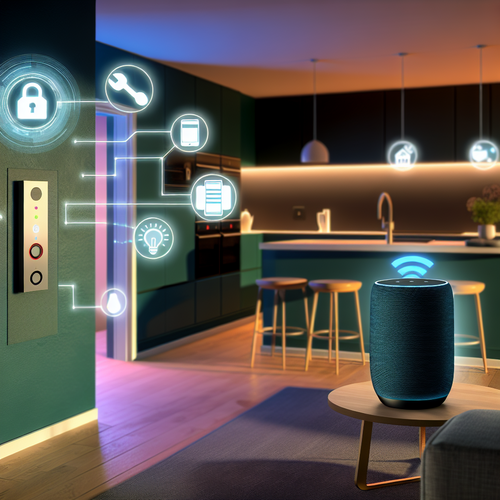🌐 How IoT Connects Devices and Turns Data into Action
The Internet of Things (IoT) is revolutionizing the way devices interact by integrating physical hardware with sensors, network connectivity, and advanced analytics to convert raw data into automated, actionable insights. IoT architecture typically consists of three foundational layers: sensing, network connectivity, and data processing. Devices embedded with sensors continuously gather real-time data on variables such as environmental conditions, usage trends, or machine status. This data is transmitted over communication networks—including Wi-Fi, cellular networks, and specialized IoT protocols like LoRaWAN—enabling seamless interactions between devices and cloud platforms or directly between devices themselves.
Once collected, the data is processed by cloud or edge analytics platforms where sophisticated algorithms detect patterns or anomalies. These insights trigger automatic responses such as adjusting a thermostat’s setting, scheduling predictive maintenance, or sending notifications to stakeholders, all without human intervention. This closed feedback loop significantly enhances operational efficiency, supports predictive decision-making, and elevates user experiences. By understanding this layered architecture, businesses and consumers alike can appreciate how sensor data evolves into intelligent actions that create smarter environments and better decisions.IBM, Cisco
🏭 IoT for Businesses: Efficiency, Predictive Maintenance & Operational Optimization
Businesses are leveraging IoT technologies to streamline process automation, enable predictive maintenance, and optimize operational workflows, generating tangible improvements in productivity and cost reduction. Real-time monitoring supported by IoT enables automatic control over manufacturing processes, supply chains, and facility management, minimizing the need for manual oversight and reducing human error. Predictive maintenance solutions employ sensor data combined with AI-driven analytics to forecast potential equipment failures before they occur. This minimizes unplanned downtime and prolongs asset longevity.
In sectors such as retail and inventory management, IoT devices monitor stock levels and environmental conditions, while enabling dynamic pricing strategies and personalized marketing efforts. These deployments typically deliver rapid return on investment by lowering maintenance expenses, increasing throughput, and enhancing customer satisfaction. When considering IoT implementations, businesses should evaluate initial costs, integration challenges, scalability, and continuing operational expenses alongside projected efficiency improvements. Setting clear key performance indicators (KPIs) aligned with business goals ensures value measurement and optimizes resource allocation throughout the IoT lifecycle.McKinsey & Company, Deloitte Insights
🏠 IoT for Homeowners: Comfort, Security and Energy Cost Reduction
Consumer-oriented IoT devices enhance home life by improving comfort, boosting security, and significantly reducing energy expenses. Smart thermostats and adaptive lighting systems tailor environmental settings based on resident routines, optimizing climate control while eliminating wasteful energy use without compromising convenience. IoT-enabled security systems — including video cameras, motion detectors, and smart locks — provide real-time alerts and remote access to safeguard homes and impart peace of mind.
Smart meters and connected appliances deliver detailed consumption data, empowering homeowners to make informed decisions that lower utility bills. When choosing home IoT devices, it is important to prioritize interoperability, ease of installation, and certified energy-efficiency ratings to maximize benefits. Additionally, opting for products with comprehensive app ecosystems and positive user feedback helps ensure consistent performance and ongoing software updates. Integrating these smart systems into everyday life allows consumers to enjoy measurable cost savings and notable quality-of-life improvements.U.S. Department of Energy, Consumer Reports
⚠️ Security, Privacy, Sustainability and Compliance Considerations
Deploying IoT solutions demands rigorous attention to security, privacy, sustainability, and regulatory compliance to mitigate risks and enhance long-term value. Common security challenges include vulnerabilities in devices, insecure communication channels, and insufficient update mechanisms, all of which expose networks to potential cyberattacks. Best practices encompass strong authentication, robust encryption of data both in transit and at rest, frequent software patches, and the adoption of zero-trust frameworks.
Privacy measures must comply with regulations like GDPR and CCPA by ensuring transparent data practices, securing user consent, and data minimization. From a sustainability standpoint, selecting energy-efficient devices and embracing circular economy models—such as device reuse and recycling—help reduce environmental impact. Organizations should evaluate vendors based on security certifications like ISO/IEC 27001, conduct thorough audits, and confirm adherence to relevant industry standards and sector-specific regulations. Utilizing comprehensive checklists covering these dimensions empowers both businesses and homeowners to select IoT solutions aligned with their security, privacy, sustainability, and legal responsibilities.NIST, ENISA
🚀 Implementation Roadmap, Vendor Selection and Real-World Examples
Successful IoT adoption follows a methodical roadmap starting with a pilot phase that tests assumptions and demonstrates value at a manageable scale. This phase involves clearly defining goals, identifying target processes or areas, and selecting interoperable devices and scalable platforms. Upon pilot success, organizations can advance to phased scaling, deeply embedding IoT capabilities into business operations or home environments.
Choosing the right vendor is critical and requires evaluating technology compatibility, security practices, customer support, and the total cost of ownership. Examining case studies and real-world examples — such as manufacturers reducing downtime via predictive maintenance or homeowners cutting energy costs with smart HVAC systems — provides valuable insights and performance benchmarks. Continuous monitoring and iterative optimization ensure the IoT deployment delivers sustained ROI and evolves to meet changing needs. This disciplined step-by-step approach minimizes risk and maximizes the benefits of IoT projects.Gartner, IEEE
📚 Resources
- Cisco – Internet of Things Overview
- Consumer Reports – Best Smart Home Security Systems
- Deloitte Insights – IoT in Businesses
- U.S. Department of Energy – Smart Home Energy Management
- Gartner – 5 Steps to a Successful IoT Implementation
- IBM – Internet of Things
- IEEE – IoT Ecosystem Report
- McKinsey & Company – The Internet of Things
- NIST – IoT Security Guidelines
- ENISA – IoT Security Guidelines

